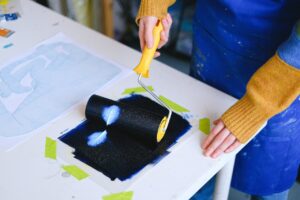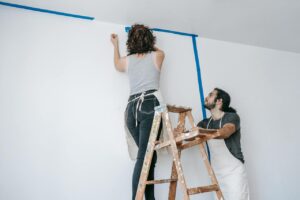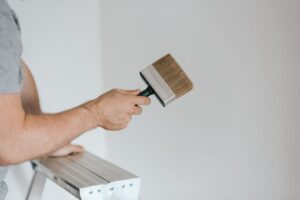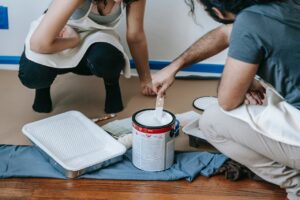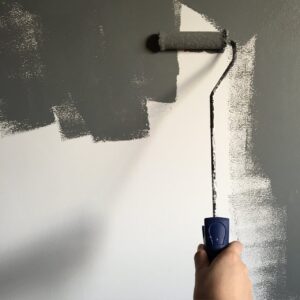
Solving Common Wall Flaws: How Textured Paints Can Help
Wall flaws can be a real headache for homeowners. From unsightly indentations and holes to uneven surfaces, these imperfections can detract from the overall look and feel of a room. There is a solution that can transform your walls and give them new life – textured paints. With their unique application method, textured paints offer an effective way to conceal common wall flaws and add character to any interior space. Understanding Wall Flaws and Textured Paints Types of Wall Flaws Wall imperfections can be a common occurrence in any home. From cracks to dents, these flaws can detract from the overall appearance of your walls. Cracks can occur due to settling or shifting of the foundation, while dents may result from accidental impacts or improper installation. Nail holes are another type of imperfection that can be left behind when removing wall decor. How Textured Paints Can Help Textured paints offer a solution to hide these unsightly wall flaws effectively. By applying textured paint, you create a visually appealing surface that helps camouflage imperfections. The texture adds depth and dimension to the walls, diverting attention away from any cracks or dents. Benefits of Using Textured Paints Using textured paints over traditional methods has several advantages. Firstly, they provide an easy and cost-effective way to conceal wall flaws without the need for extensive repairs or patching. Secondly, textured paints offer durability and resistance against wear and tear, making them suitable for high-traffic areas prone to damage. They add character and style to a room, allowing you to express your creativity through various textures and finishes. Incorporating faux painting techniques with textured paints opens up even more possibilities for creating unique designs on your walls. Faux finishes such as sponging or rag rolling can further enhance the visual appeal by adding depth and interest. Dents, and nail holes, textured paints provide an effective solution that not only hides imperfections but also adds aesthetic value to your space. The Science of Textured Paints for Wall Repair Delve into the science behind textured paints and their ability to mask flaws. Textured paints are a popular choice for homeowners looking to repair common wall flaws. But have you ever wondered how these paints work their magic? It all comes down to the science behind them. When applied, textured paints contain additives that create a three-dimensional texture on the surface of the wall. These additives can be made from various materials such as sand or other gritty substances. The purpose of these additives is to cover up imperfections like cracks, dents, or uneven surfaces by adding depth and dimension. Understand how texture additives work to create a visually appealing finish. Texture additives in paints act as fillers that help smooth out rough areas on walls. They are designed to provide coverage and hide any underlying flaws. The particles in these additives create a rough surface, which diffuses light and helps mask imperfections. The texture created by these additives also adds visual interest to your walls. It can give your space a unique look and feel, enhancing the overall aesthetic appeal of your home. Whether you prefer a subtle texture or something more pronounced, there are various options available to suit your taste. Discover the various textures available and their impact on wall repair. Textured paints offer different finishes depending on the type of additive used. Some common textures include sand finishes, popcorn textures, knockdown textures, or even faux finishes that mimic materials like brick or stone. Each texture has its own unique characteristics and can be used strategically to conceal specific flaws. For example, sand finishes are great for hiding small cracks while popcorn textures can effectively disguise larger imperfections. https://youtu.be/PwEEAG85HP0?si=B_-5gp5_PF7ziLWV Identifying Common Wall Flaws Identifying Common Wall Flaws Nail holes, water stains, and uneven surfaces are some of the most common flaws that can mar the appearance of your walls. It’s essential to identify these issues before applying textured paint to ensure a smooth and flawless finish. When assessing the severity of each flaw, start by examining nail holes. These small indentations left behind from hanging pictures or shelves can be easily filled with spackle or putty. Water stains, on the other hand, may require more attention. Look for discoloration or dark spots caused by leaks or moisture damage. Before painting over them, it’s crucial to address the source of the water intrusion and repair any underlying issues. Uneven surfaces can be another challenge. Take note of any bumps, dents, or rough patches on your walls. These imperfections can be smoothed out using sandpaper or a joint compound before applying textured paint. It is vital to address these wall flaws before painting for several reasons. Firstly, ignoring these flaws will only make them more noticeable once you apply paint. Secondly, they can affect the overall durability and longevity of your painted walls. By properly addressing these issues beforehand, you ensure a solid foundation for your textured paint application. Preparing Walls for Textured Paint Application To achieve a flawless result when applying textured paint to your walls, it is crucial to follow a step-by-step guide for wall preparation. This ensures that the texture adheres properly and creates the desired effect. Let’s explore some essential techniques for preparing your walls before applying textured paint. Cleaning, Sanding, and Priming Techniques Start by thoroughly cleaning the wall surface to remove any dirt, dust, or grease. A clean surface allows the textured paint to adhere better and ensures a smooth finish. Next, sand the walls using fine-grit sandpaper to create a slightly rough texture. This helps the paint grip onto the wall surface effectively. After sanding, it’s important to prime the walls before applying textured paint. Primer creates a uniform base and improves adhesion, making sure that the texture stays intact over time. Choose a primer specifically designed for textured surfaces or consult with your local hardware store for recommendations. The Importance of Proper Preparation Properly preparing your walls sets the foundation for a successful textured paint application. Without adequate

